
| |
|
Cover |

|
Click on pictures to enlarge and click your back
button to return. |
|
January |

|
|
|
This is a picture of the 1963 Nesquehoning Warriors
football team. Nesquehoning used the name “Indians” until 1956. In
1956 the student body voted to change the name from the Nesquehoning
Indians to the Nesquehoning Warriors. First Row: L. Gazdick, G. Malaska,
R. Newton, J. Ligenza, J. Mauro, J. Slivka, S. Ligenza. Second Row: D.
Conway, V. Gogal, A. Bochicchio, J. Drosdak, M. Misoda, T. Whitehead, P.
Skodacek, J. Pizzuttie, S. Sehar. Third Row: M. Bonner, M. Kusko, J.
Murlo, R. Tokay, T. Dolinsky, T. Pituch, A. Malaska.
|
|
February |
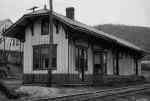
|
|
This is a picture of the New Jersey
Central train station at Nesquehoning. In the early years the train
station was a hub of activity. At one time trains were the only form of
transportation. Passenger trains ran of a precise schedule, people sat
in the waiting room at the station until the train arrived. Freight
trains delivered almost everything the people needed. The train dropped
off the items at the station and people either picked them up themselves
or had a local express company deliver them to their house. Before
telephones, telegrams were used to send messages to people. This was
also done at the train station. The station was used by the railroad
until the 1960’s and it burned down in the 1970’s. |
|
March |

|
|
This
is a picture of W. Catawissa St. in 1905. Trolley service came to
Nesquehoning in 1902. There was one pair of tracks except in certain
places where double tracks were installed. The 100 block of W. Catawissa
St. had double tracks. This is where the eastbound and the westbound
trolleys could pass each other. In 1931 buses took the place of the
trolley cars and the tracks were removed. |
|
April |

|
|
This
is a photo of miners at the bottom of a coal shaft in the late 1890’s.
To mine a lump of anthracite takes about thirty-five men, each with
distinct duties, exclusive of the engineers and surveyors who lay out
the property and drill for coal and the contractors who sink the shaft
and start the tunnels. After all this is done comes the contract or
company miner who drills holes in the vein and blows down the coal with
explosives. Then comes the miner’s laborer who loads the coal into
mine cars. In pitching veins “loaders” load the coal through chutes
and send the “trips” of cars to the shafts. In order that these
workers may have a constant supply of fresh air, there must be door
tenders to open and shut the doors, which direct the air currents,
brattice men to build the partitions also necessary to direct the air
and engineers to run the big exhaust fans at the outlets. Masons are
needed for the construction around the foot of the shaft, in the pump
rooms, in the main gangways, at crosscuts and in the mule stables, and
lamp men to clean and repair the lamps. In gaseous mines expert “shot
fires” are employed to handle the explosives. Stationary engineers are
necessary for the engines of the pumps and hoists below ground, and
compressed air and electric locomotive engineers and mule drivers in
order to haul the coal to the shafts. Runners to take the mine cars from
the face of the vein to the gangways where they are coupled to the
“trips”, or trains, road cleaners, track repairmen, brakemen,
stablemen, mule shoers, car oilers, and a veterinary are all necessary
parts of this transportation system below ground. At the shafts there
must be headmen and footmen, shaft repairmen and hoisting engineers, and
for drainage there are pumpmen and water bailers for places where no
pumps have been installed. There are also water-hoisting engineers for
places where the water is hoisted out of the “sumps,” in great
tanks. Some of the other necessary employees are rockmen rock stowers,
timbermen, machinists, carpenters, and electricians whose titles
indicate their activities. The siltsmen direct the currents of refuse
hydraulicked back into the mines, there is plenty of repair work and odd
jobs for the company laborers, corps of rescue men are constantly ready
for emergencies, and the inside foreman and his assistants direct the
work, and keep up a constant inspection of the of the mines. There are
nearly twice as many occupations for the men above ground in the
colliery yard and in the breakers who receive the coal and prepare it
for market. The titles of the positions vary with the different
companies but the foregoing outline of what is necessary below ground
gives some idea of the internal economy of an anthracite mine. |
|
May |

|
|
Above
is a newspaper clipping from the 1940’s. During WWII Nesquehoning was
one of the most patriotic towns in the Country. On a per capita basis,
Nesquehoning had more people in the armed services than any other town
in the whole United States, (over 1200 men and women.) This clipping
came out of a scrapbook kept by a Nesquehoning resident; it contained
hundreds of newspaper articles about the men and women from Nesquehoning
that enlisted in the armed services during WWII. Even a dog from
Nesquehoning was enlisted in the army by its owner Joseph York. The dog
was a pedigreed black German Shepard, his name was Diamond. After he
completed combat training at Fort Robinson Nebraska he was designated
10E9 and sent into action. The Army said the “War Dogs” were of
enormous value in the front lines. The service men and women from
Nesquehoning have an admirable record of being the hardest working and
hardest fighting solders in the war. Many never returned and were buried
in graves in distant parts of the world. One Nesquehoning soldier said
his saddest memories are of the days when as bugler for his company, he
played taps over the freshly dug graves of his friends from
Nesquehoning. One of the Countries first casualties in WWII was from
Nesquehoning. Joseph Malatak was killed on Dec 7, 1941 at Pearl Harbor.
Thirty-four people from Nesquehoning lost their lives in WWII. |
|
June |
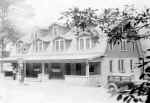
|
|
This is a picture of Zaengle’s Grove
Inn in the 1930’s. The sign above the gas pump says: – Tourist –
Rooms & Baths – Meals Served – Zaengle Grove Inn – Garage
Space. The price for gas was 13 cents and 2 cents tax. Zaengle’s Grove
was considered the finest camping ground for tourists in this area and
much of its popularity was given to the earnest efforts of Mr. Ralph
Simmons, the manager who was well known throughout the entire valley
having lived here since 1890. Mr. Simmons conducted a rest station near
the grove and was fully prepared to serve hot lunches and refreshments
at all hours. The refreshment stand catered to a large tourist trade and
offered the best service obtainable in the region. This is the present
site of Ferrence Floor and Decor and Advantage Reality. |
|
July |
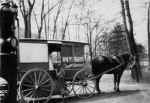
|
|
This is a picture of Samuel Simmons
butcher wagon. He opened a butcher shop on West Catawissa St in the late
1800’s; it was located on the lot now occupied by the Turkey Hill Mini
Mart. Each day he would travel the streets of Nesquehoning going
door-to-door selling meat from his wagon. The purchased of a truck in
the 1930’s enabled him to carry more items besides meat. Painted on
the side of his truck was the slogan “Simmon’s, the store at your
door.” Written on this picture was Bob Marsden 1928 and the dog
looking for a hand out was named Lindy. Bob Marsden was a butcher that
worked for Simmon’s. Marsden would later buy the business and operated
it into the 1960’s. On May 8, 1977 the building and a hotel next to it
were destroyed by one of Nesquehoning’s worst fires. The Marsden’s
were lucky to escape with their lives. Fireman Michael Kravelk’s fast
action was responsible for averting what could have emerged as a
tragedy. He entered the burning building where the Marsdens were asleep
and led them to safety. |
|
August |
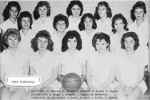
|
|
This is a picture of the 1961 girls
basketball team. The picture is from the 1961 Nesquehoning High School
yearbook. Nesquehoning yearbooks were called the Arrow. Nesquehoning's
first yearbook was in 1950. There was no year on the cover, it only said
ARROW. Mr. Rudy Bednar, of Nesquehoning, took the pictures. Most of the
text in the book was done on a typewriter. 1951 and 1952 were the only
years the book was soft cover. Photos were by Rudy Bednar and text was
still done on a typewriter. In 1953 the text, pictures and especially
the ads that now included logos and clipart made the book much better.
The 1954 book had a padded cover and was the thickest book of all,
because pages were only printed on one side. This book also contained
the only photo of the football team in their regular clothes and not in
their football uniforms. The 1955 and 1956 books were made by Myers and
contained more pictures, especially of activities. From 1957 to 1963 the
books were made by Taylor and the last book in 1964 was made by Delmor.
The first school at Nesquehoning was in the year 1830, who would have
thought that the end would come in 1964. On the last page of the last
yearbook is a picture with the fitting caption, "The End." |
|
September |

|
|
This
is a picture of the Eagle Hotel taken in the early 1900’s. It was
located at Catawissa and Ratcliff streets, the site of the present day
Turkey Hill Mini Mart. The Eagle Hotel was one of Nesquehoning’s
oldest and best-known landmarks, being a licensed place as far back as
1846, when the hostelry was owned by the late James McCabe. In 1874 it
changed hands, the late Patrick McKenna becoming its owner and
proprietor, and who later allowed the license privilege to lapse and
rented the place to the late Samuel Steventon, who established a
flourishing general store business and ran it with unusual success until
1883 when the property was purchased from the McKenna estate by John
McCaffrey. Mr. McCaffrey revived the license and the Eagle once more
took on new life as a place of entertainment. Following his demise in
1895, Patrick McMahon became proprietor and conducted the hotel until
1913 when he also was called to his eternal reward. Thomas E. McCaffrey
then succeeded to proprietorship of the place and being a young man with
pronounced modern ideas and capability out of the ordinary, he at once
put into execution plans that would materially aid him in building up
and maintaining a business in keeping with the rapid advancement of the
times. To accomplish this end, he inaugurated alterations and
improvements that completely transformed this well-known bar. The room
was enlarged and thoroughly equipped with the latest in appointments, a
handsome marble front bar, with elegant back bar, fixtures installed and
such facilities and conveniences provided that brought this house into
the front ranks of the leading hotels. Mr. McCaffrey enjoyed
immeasurable success, his thorough knowledge of the business in all its
intricate details, his keen wit, accommodating nature and otherwise
pleasing personality popularizing the place to a degree never before
experienced. On 10-6-1916 he arranged to get the World’s series games
having engaged a special telegraph wire direct from the Boston and
Brooklyn grounds for the occasion. A person was assigned to translate
the dots and dashes of the morse code for the patrons. He also held fox
chases and invited all huntsmen having good dogs to join in the chase of
three foxes. Mack, as he was familiarly called, held banquets for up to
200 people, he would have 25 young ladies engaged as waitresses serving
food prepared by his chef, Jack Koons, who was formerly chef of the
White House, Washington, D. C. and the Astor House, N. Y. In 1923
the business was sold to John Guy, a hotelman, of Coaldale. The building
was destroyed in one of Nesquehoning’s worst fires on May 8, 1977. |
|
October |
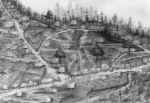
|
|
Pictures
of Little Italy are very rare. Above is an old painting of the village
done by one of it residents, Frank Romano. Little Italy was a quaint
little village nestled among the rocks and hills one mile above
Nesquehoning on the top of Wash Shanty Hill. The settlement was started
in 1884 and occupied mostly by Italians. Little Italy was one of the
most unique villages in America; it got its name from its resemblance to
villages in Italy. The residents made everything look as nearly like
their Italian homes and did everything as nearly like they used to do it
in the old country, and the result was one of the strangest little
settlements not only in this section but in America. They held annual
celebrations and the town was beautifully decorated with flags and
bunting. The streets were illuminated with fifteen hundred glass
lanterns and hundreds of Chinese lanterns. Tony Malaska was in charge of
the fireworks and were something beautiful. Strings of fireworks were
stretched along the streets for great distances and others were arranged
on the mountainside and consisted of spin wheels, rockets and many other
beautiful designs. Little Italy was always pointed out as a curiosity
and thousands of sightseers visited it yearly. Not many got sick in
Little Italy and a funeral out of the village was a rarity, it had the
reputation of being the healthiest spot in the entire coal region. It
was also the scene of many a brawl and stabbing fray and several of this
areas most sensational murders are believed to have been hatched out
there. In 1912 residents of Little Italy got the bad news, it was doomed
to go. Because it sat on top of a large vein of coal the Lehigh Coal and
Navigation Company decided to extend its working directly underneath it
and this made it unsafe for anyone to live there. It was decided to move
Little Italy to Newtown. Newtown was located on the north side of
Nesquehoning Creek. By 1917 almost every one from Little Italy was moved
to Newtown. On October 15, 1917 at 5:30 Friday afternoon a great flag
rising was held. Two tall poles, fully 60 feet high, were erected side
by side and a flag was swung to the top of each amidst the firing of a
salute and cheers of the crowd. One was a large silk American flag and
the other Italy’s national banner. The towns name was changed from
Newtown to New Columbus. Even though most people thought Little Italy
was a deserted village in 1922, Mr. and Mrs. Bruno Donato and family
were still residing there in what was the old school, but even in such
isolation the good old stork had them and their habitat in his
directory. It paid them a visit on Thursday October 28th and left with
them a brand new baby boy. |
|
November |

|
|
This photo of the 1888 Nesquehoning
Breaker had the following writing on it “This was the 3rd Breaker
in Nesquehoning, started to work in 1888 and was torn down in 1908.
Harry A. Strohl started to pick slate in September 1890 when 10 years
old for 36 cents per 10 hour day.” Most people are aware of the
dangerous job the miners had, working in tunnels hundreds of feet
underground. Explosions, cave-ins, poison gasses and flooding, killed
many. The coal breaker was also a very dangerous place to work. Many
injuries and deaths occurred at the breaker. Men were crushed between
coal cars; some would get caught between unprotected revolving wheels,
ropes, belts and scraper lines. Many received terrible burns and even
killed by bursting steam pipes and boilers. Some of the slate pickers,
victims of their own curiosity came to grief and filled early graves.
Leaning out of the windows of the high wooden structures they topped to
their death. One of the most heart wrenching sights is that of the young
boys who went to work at the coal breaker picking slate. Children as
young as seven years old sat in their positions near the chutes, always
facing the endless stream of coal and removed slate, rock, slag, wood
and other impurities mixed with the coal. These young children taken
almost from the cradle to the coal-breaker, and there subjected to the
most inhuman cruelties at the hands of brutal and ignorant
cracker-bosses, whose own lives were rendered callous by contact with
such scenes from childhood, and who had a firm belief that the only way
to control a boy or mule was with the lash, and that it should be laid
on unsparingly to make boy or mule do his duty. The person in charge of
the boys was called the Cracker-boss who usually carried a stick or some
had leather whips. Some of these children were severely beaten by
drunken cracker-bosses for getting into mischief or falling asleep. |
|
December |

|
|
Today
the neighborhood grocery store is just a memory. But for residents of
New Columbus Miranda’s Groceries & Meats store at 231 West
Columbus Avenue was the place where they could buy fresh meats, homemade
sausage, vegetables and even some specialty items as advertised in this
photo: a white enamel dish pan filled with soaps for 98 cents, Beech-Nut
or Mail Pouch Chewing Tobacco (a staple for the miners), or
Yuengling’s Ice cream made in Pottsville. Keeping an eye on the store
are (from left to right) Antoinette (Miranda) Cassano, Pauline Miranda,
owners Antonio and Olivia Miranda, and Rosalie (Miranda) Augustine. This
photo is circa 1920’s. |
|
Inside Back Cover |

|
|
|
The photo above is a plan for a recreational site in
1950. It was to be built in the area now occupied by various businesses.
It would have started at the present day Gnaden Huetten Hospital Therapy
Center to Maple Shade Meadows.
In 1950 our town leaders vowed to do something to get
the children off the streets. They envisioned a program whereby parks,
pools and year-round recreational facilities could be set up. They said
when the entire program is completed; Nesquehoning will have that most
important factor of all – adequate facilities for wholesome recreation
for its youth as well as restful sites for its adults. Four parks were
contemplated. The main park will be placed on the site of the old
Nesquehoning dump, long an eyesore to the community. Here they hoped to
place a swimming pool, properly supervised and other outdoor facilities.
A second park will be placed in New Columbus, on the spacious lot
between Messina and Venice off Columbus and Garibaldi Avenues. This lot,
originally secured as a park site, has been laying idle for 22 long
years. It will be graded and will be landscaped by qualified
technicians. A tennis court, softball field, sidewalks, benches and
other park attributes will be created. The third park will be at the
eastern end of the community, where the “Roadside Rest” is nearing
completion; a small park will be created to adjoin the motorists’
retreat. The fourth park will be created in the vicinity of the mule
stable. Here will be placed a softball field, outdoor shuffleboard, and
a variety of other recreational items. The concern evidenced by the
supervisors immediately after they took office showed black and white
results in the accident records of the town. Temporary recreational
programs were set up through the help of community residents and
officials. Chief of Police Edward McGinley, tireless worker for the
benefit of the community’s youth, began to make regular visits to the
danger areas – the railroad tracks, streets where children played and
the swimming holes at the “Mud Cut” and the “First Hollow.” To
some of the youngsters the burly chief’s actions seemed unfair. But
his only concern was their safety. Mean while, the boys and girls were
being introduced to something that offered much more fun through its
variety, supervised play. Gradually the streets began to lose their
hordes of gamboling children and gradually the supervised play began to
attract more and more young folks. The town records are the proof of the
pudding. The year before the youth program was launched there were 13
accident cases involving children with cars and trains. Last year only
one such accident occurred.
The next question was “Who Shoulders The Cost?”
An old-fashioned town meeting was held at the Hose Company. One of the
supervisors said, nothing is done gratis these days; the money would
have to come from the taxes. It was said a small tax levy of a half mill
was needed to pay for the project. Chief McGinley said “the first love
of a boy or girl is not crime, but keeping busy with sports, games, the
outdoors and affairs of interest to their youthful mentalities. The
programs underway and in prospect are designed to meet these needs. The
cost of rearing clean, wholesome children cannot be weighed in money or
in tax burdens. And in taking its progressive steps, Nesquehoning is
setting a bright example for other communities that had suffered for
years under the same inadequacies.”
Everyone in town thought the parks project was a good idea, but they
didn’t want a tax increase. A house-to-house canvass and other
money-raising schemes failed and the plan for the parks was stopped.
This is the 11th year for the Nesquehoning
calendar. It’s been hard to find old pictures of Nesquehoning and that
continues to be a problem. I want to thank all the people that helped
make the calendars possible, especially the businesses that stuck with
us all these years. With out their support the calendars would not be
possible. The calendars were done to enlighten everyone of the history
of Nesquehoning; I hope it has done that. The discovery of coal in
Nesquehoning in 1785 was a historic event not only for Nesquehoning but
also for all America. Nesquehoning’s contribution to the industrial
revolution is without reproach. While our forefathers were forming a new
nation in Philadelphia they were kept warm in the winter and cooked on
stoves heated with coal from Nesquehoning. In fact most coal dealers in
Philadelphia demanded that the coal they received come from
Nesquehoning’s Room Run mine. During wars miners at Nesquehoning
worked 24 hours a day. Coal furnished heat for peoples homes, the power
to drive engines, locomotives, steamships, and dynamos that produced
electricity. Without coal the railroads were useless. There could not be
too much coal mined to make iron for rails, locomotives and ammunition.
Coal was a precious commodity especially during wars. Miner’s worked
under the most intolerable and inhumane conditions of employment
imaginable. They went down into the bowels of the earth each day,
knowing that he may or may not return, perhaps descending to their
everlasting tomb. Many of our fathers, grand fathers and great grand
fathers died in the mines or succumbed later from “black lung”
caused from breathing in all the coal dust. Patriotism also played a big
part in our town’s history. When our Country was in need, our
residents were always there to answer the call. During WWII Nesquehoning
was one of the most patriotic towns in the Country. On a per capita
basis, Nesquehoning had more people in the armed services than any other
town in the whole United States, (over 1200 men and women.) Nesquehoning
and its people have a great history, be proud of it and keep up the good
work. |
|
Back Cover |
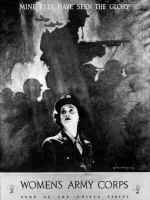
|
|
|
This is the most famous Women’s Army Corps
recruiting poster, artist Jes Schlaikjer did it during WW II. When
General George C. Marshall saw it for the first time, he exclaimed,
“Mine eyes have seen the glory.” When photographers down at
Ellington Field in Texas saw Corporal Helen McConnon’s dimples and
Hollywood smile they promptly nominated her as “the most photogenic
WAC north of the Rio Grande. She was then voted “the most photogenic
WAC” in the U. S. service and artist Schlaikjer put Helen on this
nationally distributed poster. Her photogenic possibilities were
discovered when she was training at a southern camp. She went to
Ellington Field in Texas where she had an important job in Post
Operations and then was engaged in administrative work with the
Woman’s Army Corps in France. Helen was described as a brown-eyed
brunette, petite and pretty at 5 feet, 3 inches and 110 pounds. She is
23 years of age and her home in Nesquehoning is at 257 W. Railroad St.
Another remarkable fact is Helen came from a 7 star family; her two
sisters and four brothers were also in the armed forces, giving the
family a proud military record in World War II. |
|